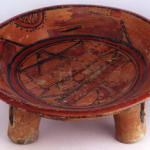Mayan Royal Ritual Tripod Plate, 600 CE - 900 CE
Terracotta
PF.2926
According to Maya mythology, the gods’ formed man from maize. The Maya identified maize and blood as the most potent substances. The crosshatched half circles on the inner rim of...
According to Maya mythology, the gods’ formed man from maize. The Maya identified maize and blood as the most potent substances. The crosshatched half circles on the inner rim of this ritual plate symbolize the essence of the Maya: maize. It is unlikely that the king and his retinue were involved in tending maize, but they undoubtedly monitored the progress of maize crops in the raised fields within their provinces. The king probably performed many rituals tied to the development of a crop; he may have sown the first kernels or led the reapers to the fields. Depicted on this vibrantly painted ritual plates are not kings performing their rituals, but royal women. Evidence suggests that royal women may have also performed rituals based on the labor of ordinary women. Three women dressed in royal headdresses sit in profile before their metates grinding corn on the inner rim of this plate. Manos and metates, grindstones for maize, are frequently recovered from palace debris by archaeologists not, we assume, because elite women were grinding corn day in and day out, but because maize was ground ritually for certain celebrations. While plants grow from the fertile earth, perhaps the center of the plate depicts the timely provision of water from the heavens that are mandatory for the maize to grow. Thus this plate could represent a celebration in reverence to the upper and lower realms of spirit, the heavenly timely rains and the fertile earth, for delivering abundant maize crops essential for the ancient Mayan's survival. Because corn was in fact the essential sustenance of man, the process of its growth provided a symbolic pattern which the Maya could make sense of the basic cycle of all life. This cycle is perceived as four stages which are represented by the four symbols on the outer rim of this plate: (1) the birth from a dead seed, (2) the regular stages of growth to the point of maturity, (3) followed by the harvest and the cutting and burning of the dead stalks, (4) followed then by the planting of the "dead" seed to begin the new cycle. This cyclical pattern of the corn promised the immortality of regeneration. . . the living proof that the life force never dies which is so cleverly portrayed on this beautiful plate.



